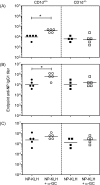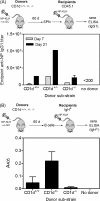Reduction of CD1d expression in vivo minimally affects NKT-enhanced antibody production but boosts B-cell memory
- PMID: 21398691
- PMCID: PMC3066037
- DOI: 10.1093/intimm/dxq477
Reduction of CD1d expression in vivo minimally affects NKT-enhanced antibody production but boosts B-cell memory
Abstract
The CD1d-binding glycolipid α-galactosylceramide exerts potent adjuvant effects on T-dependent humoral immunity. The mechanism is driven by cognate interaction between CD1d-expressing B cells and TCR-expressing type I CD1d-restricted NKT cells. Thus, far positive effects of alpha-galactosylceramide have been observed on initial and sustained antibody titers as well as B-cell memory. Following vaccination, each of these features is desirable, but good B-cell memory is of paramount importance for long-lived immunity. We therefore tested the hypothesis that CD1d expression in vivo differentially affects initial antibody titers versus B-cell memory responses. CD1d(+/+) and CD1d(+/-) mice were generated and immunized with antigen plus CD1d ligand before analysis of cytokine expression, CD40L expression, initial and longer term antibody responses and B-cell memory. As compared with CD1d(+/+) controls, CD1d(+/-) mice had equivalent numbers of total NKT cells, lower cytokine production, fewer CD40L-expressing NKT cells, lower initial antibody responses, similar long-term antibody responses and higher B-cell memory. Our data indicate that weak CD1d antigen presentation may facilitate good B-cell memory without compromising antibody responses. This work may impact vaccine design since over-stimulation of NKT cells at the time of vaccination may not lead to optimal B-cell memory.
Figures





References
-
- Taniguchi M, Harada M, Kojo S, Nakayama T, Wakao H. The regulatory role of Valpha14 NKT cells in innate and acquired immune response. Annu. Rev. Immunol. 2003;21:483. - PubMed
-
- Fujii S, Shimizu K, Kronenberg M, Steinman RM. Prolonged IFN-gamma-producing NKT response induced with alpha-galactosylceramide-loaded DCs. Nat. Immunol. 2002;3:867. - PubMed
-
- Hermans IF, Silk JD, Gileadi U, et al. NKT cells enhance CD4+ and CD8+ T cell responses to soluble antigen in vivo through direct interaction with dendritic cells. J. Immunol. 2003;171:5140. - PubMed
Publication types
MeSH terms
Substances
Grants and funding
LinkOut - more resources
Full Text Sources
Molecular Biology Databases
Research Materials

